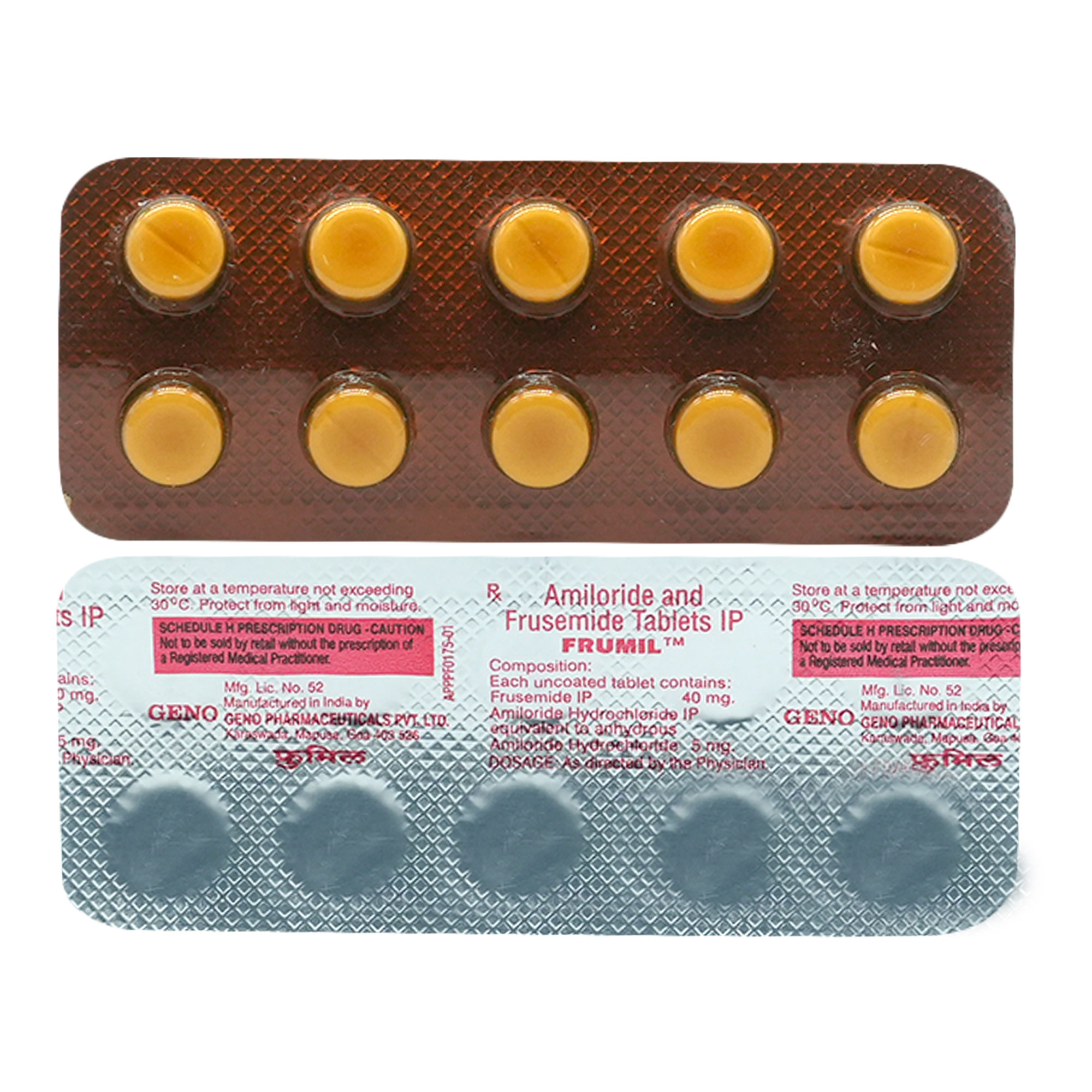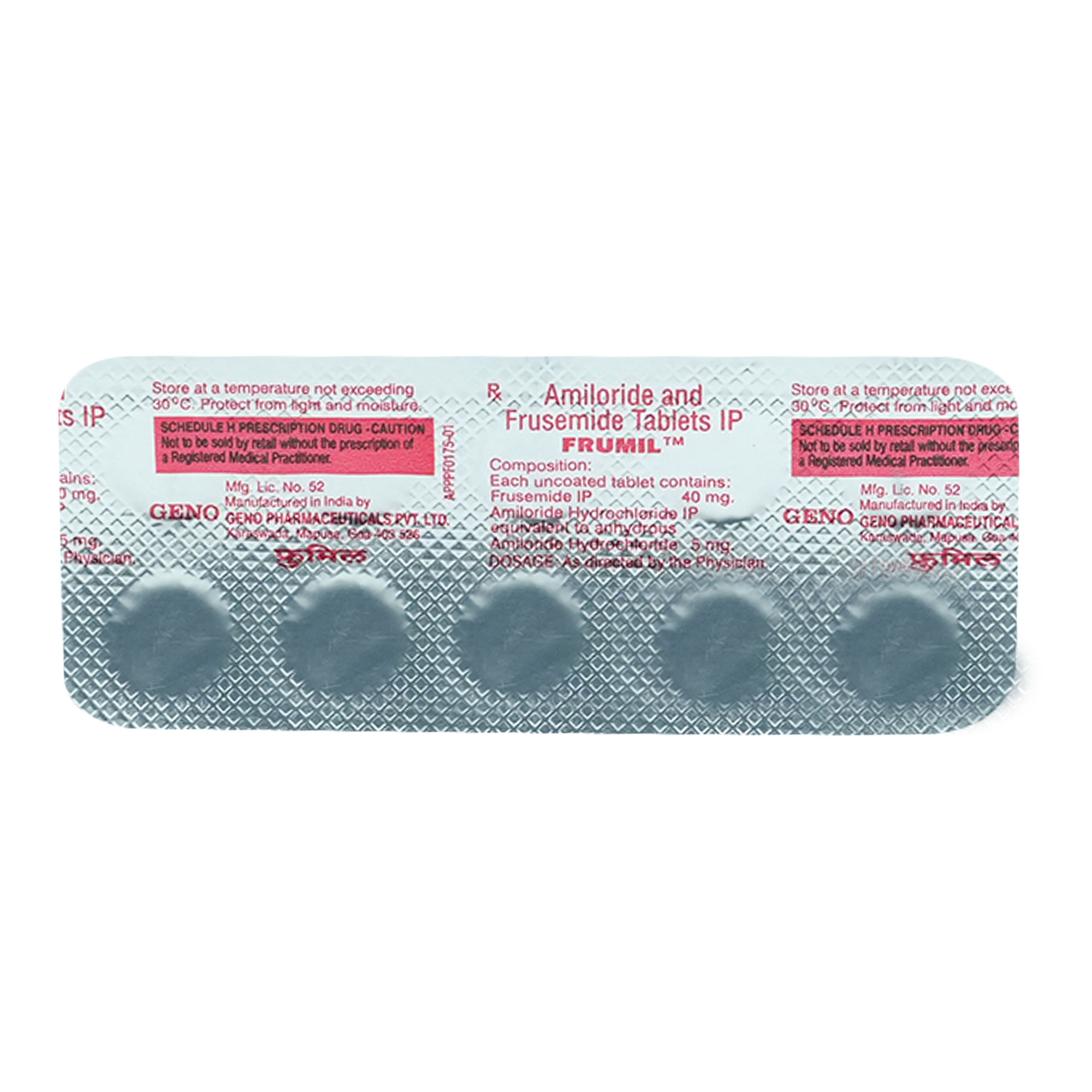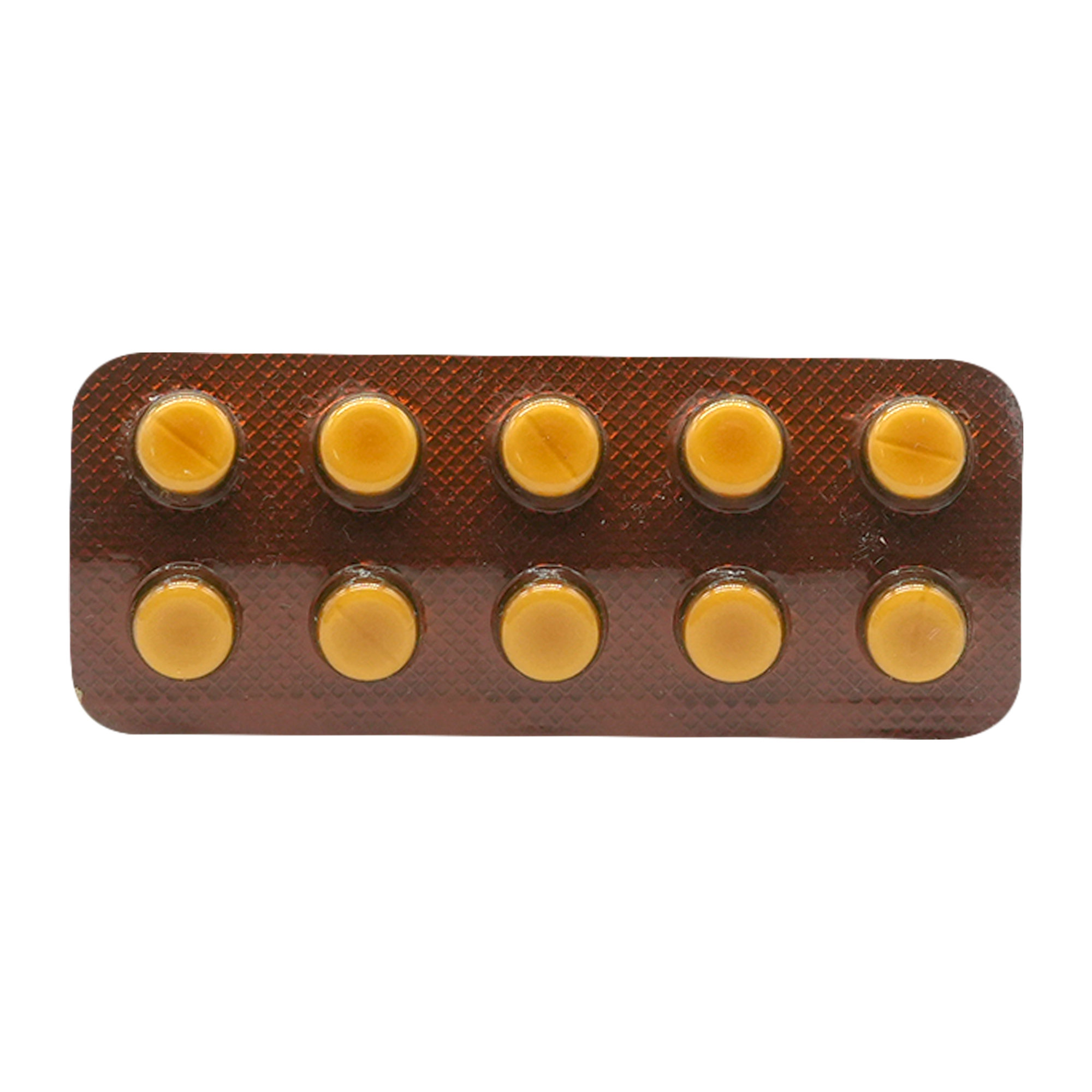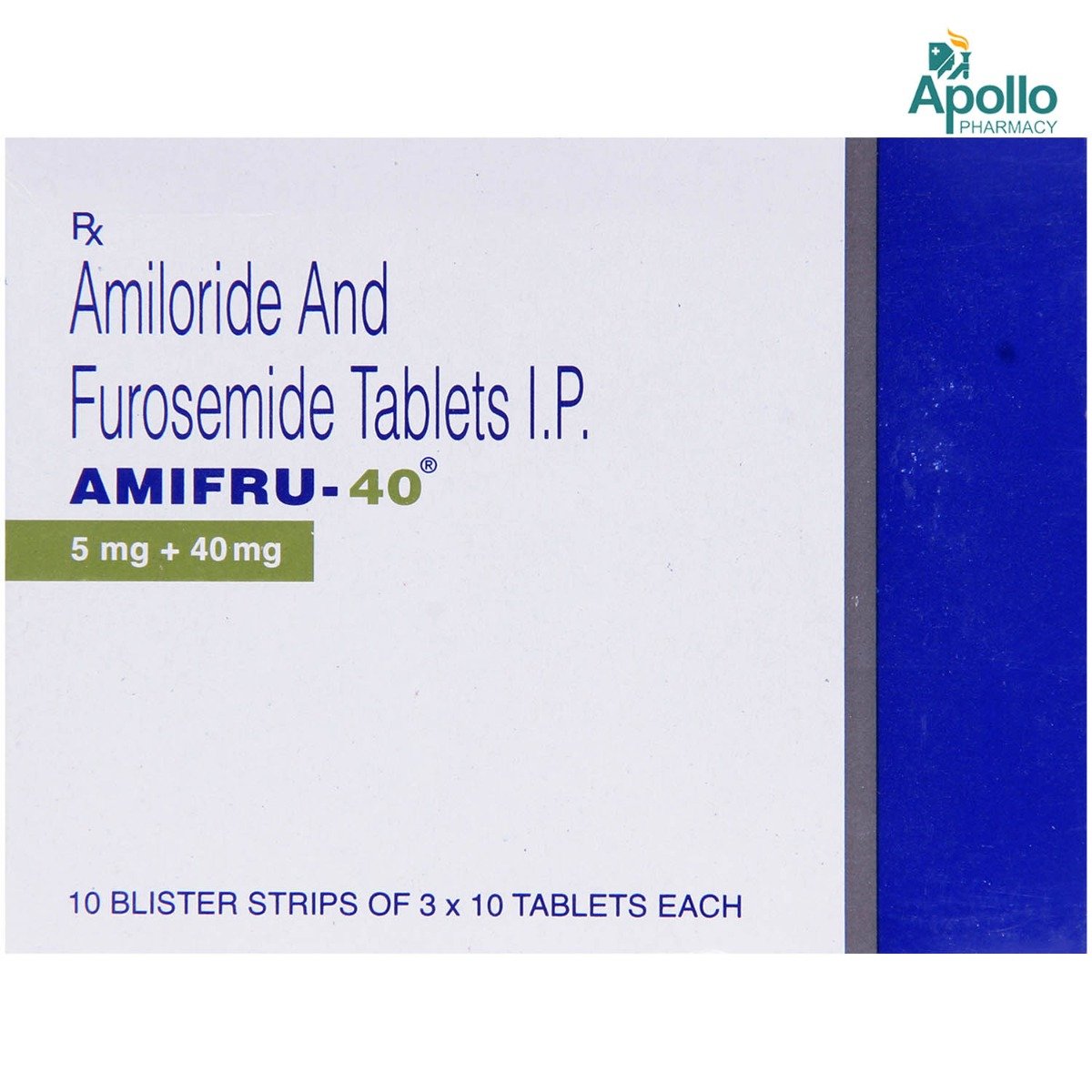Frumil Tablet



MRP ₹9.5
(Inclusive of all Taxes)
₹1.4 Cashback (15%)
know your delivery time
Provide Delivery Location
Composition :
Manufacturer/Marketer :
Consume Type :
Expires on or after :
Return Policy :
NPPA :

Secure Payment

Trusted by 8 Crore Indians

Genuine Products
Therapeutic Class
Country of origin
Manufacturer/Marketer address
Author Details
We provide you with authentic, trustworthy and relevant information
Disclaimer
Alcohol
Safe if prescribed
Alcohol may lower your blood pressure. It would help if you avoided or limit consuming alcohol whilst taking Frumil Tablet
Pregnancy
Consult your doctor
It is advised to seek medical advice before using Frumil Tablet if you plan to conceive or pregnant before starting Frumil Tablet .
Breast Feeding
Consult your doctor
Frumil Tablet may pass into the breast milk during breastfeeding. Please consult your doctor before using Frumil Tablet if you are a lactating mother.
Driving
Safe if prescribed
Frumil Tablet may cause side effects due to lowering of the blood pressure such as dizziness or tiredness. If you feel dizzy or tired when taking this medicine, do not drive or use any tools or machines.
Liver
Consult your doctor
Let your doctor know if you have any history of liver diseases before using Frumil Tablet . Frumil Tablet is to be administered with caution in patients with severe hepatic impairment.
Kidney
Consult your doctor
Frumil Tablet to be taken with caution, especially if you have a history of Kidney diseases/conditions. Your doctor may adjust your dose depending upon your current kidney conditions.
Children
Safe if prescribed
Frumil Tablet is not recommended for use in people below 18 years as the efficacy and safety have not been established.
Product Substitutes
About Frumil Tablet
Frumil Tablet belongs to the class of 'diuretic drugs or water pills', primarily used to treat hypertension (high blood pressure) and oedema (fluid retention). Hypertension is a medical condition, in which the blood exerts high pressure (force exerted by circulating blood) against blood vessel's walls. This condition makes the heart to work harder in pumping the blood to the whole body. Hypertension can cause severe health complications, including stroke, heart failure, heart attack and kidney failure. Oedema is a condition caused by a build-up of fluid and swelling in the ankles, feet and legs.
Frumil Tablet prevents the build-up of extra water in the body. This excess water can cause swollen ankles, shortness of breath and tiredness. It iconsists of Furosemide (loop diuretic) and Amiloride (potassium-sparing diuretic). Furosemide inhibits reabsorption of sodium and chloride in the ascending loop of Henle and proximal and distal renal tubules (different parts of the nephron in the kidney). Amiloride inhibits sodium-potassium exchange in the distal tubule of nephron (functional unit of the kidney). Frumil Tablet helps in clearing the excess fluids in the body in the form of urine.
Your doctor will advise you how often you take Frumil Tablet based on your medical condition. Like all medicines, Frumil Tablet can cause side effects, although not everybody gets them. Some common side effects of Frumil Tablet include dizziness, light-headedness, headache, blurred vision, nausea, vomiting, loss of appetite, stomach/abdominal pain, gas and diarrhoea. Most of these side effects of Frumil Tablet do not require medical attention and gradually resolve over time. However, if the side effects are persistent, please reach out to your doctor.
Do not stop taking Frumil Tablet without consulting your doctor since it may worsen your condition and increase the risk of future heart problems. Inform your doctor if you have any untreated salt/mineral imbalance (high potassium, low sodium level), kidney disease, liver disease, diabetes, dehydration, gout, hearing loss, Addison's disease (adrenal insufficiency), dehydration and lupus (an autoimmune disease of tissues). Please tell your doctor if you are taking any other medicines or have any allergic reactions to Frumil Tablet . Reducing the amount of table salt (sodium chloride) in your food often relieves the body's swelling. If you are pregnant or breastfeeding, please tell your doctor so that the dosage of Frumil Tablet can be prescribed accordingly.
Uses of Frumil Tablet
Medicinal Benefits Mweb
Key Benefits
Frumil Tablet prevents the build-up of extra water in the body and treats hypertension (high blood pressure) and oedema (fluid retention). Frumil Tablet is a combination of medicine that consists of Furosemide and Amiloride. Furosemide is a 'loop diuretic' that treats high blood pressure, fluid retention (oedema) in people with congestive heart failure, liver disease or nephrotic syndrome (a kidney disease). Amiloride is a 'potassium-sparing diuretic' and treats hypokalemia (low potassium levels in the blood) in people with high blood pressure or congestive heart failure. Frumil Tablet works by acting on different parts of the kidney to remove extra fluid and certain electrolytes while maintaining the body's potassium balance. Frumil Tablet clears the excess fluids in the body in the form of urine.
Directions for Use
Side Effects of Frumil Tablet
- Dizziness
- Light-headedness
- Headache
- Blurred vision
- Nausea
- Vomiting
- Loss of appetite
- Stomach/abdominal pain
- Gas
- Diarrhoea
Drug Warnings
Do not use Frumil Tablet if you are allergic to Frumil Tablet or any of its components. Let your doctor know if you have any untreated salt/mineral imbalance (high potassium, low sodium level), kidney disease, liver disease, diabetes, dehydration, gout, hearing loss, Addison's disease (adrenal insufficiency), dehydration and lupus (an autoimmune disease of tissues) before starting Frumil Tablet . Therapy with loop diuretics should be administered cautiously in patients with diabetes mellitus, glucose intolerance, or a history of hyperglycemia (high glucose levels) since Furosemide affects your blood sugar levels. Pregnant and breastfeeding women should consult a doctor before using Frumil Tablet . Frumil Tablet can increase the chances of light-headedness so rise slowly if you are sitting/lying and avoid operating any machine or doing any work that needs mental alertness.
Drug-Drug Interactions
Drug-Drug Interactions
Login/Sign Up
Taking Ziprasidone with Frumil Tablet can increase the risk of abnormal heart rhythm.
How to manage the interaction:
Taking Ziprasidone with Frumil Tablet is not recommended, but it can be taken together if prescribed by a doctor. However, consult your doctor if you experience sudden dizziness, lightheadedness, fainting, shortness of breath, weakness, tiredness, drowsiness, confusion, muscle pain, cramps, dizziness, nausea, or vomiting. Do not discontinue any medications without consulting a doctor.
Coadministration of Frumil Tablet with Drospirenone may increase potassium levels in the blood.
How to manage the interaction:
Taking Frumil Tablet with Drospirenone may lead to an interaction but can be taken if prescribed by the doctor. However, consult the doctor if you experience nausea, vomiting, weakness, disorientation, tingling in your hands and feet, feelings of heaviness in your legs, a weak pulse, or a slow or irregular heartbeat. It is advised to reduce intake of potassium-rich foods such as tomatoes, raisins, figs, potatoes, lima beans, bananas, plantains, papayas, pears, cantaloupes, mangoes, and potassium-containing salt substitutes. Do not stop using any medications without talking to a doctor.
Coadministration of Frumil Tablet with Spironolactone may increase potassium levels in the blood.
How to manage the interaction:
Taking Frumil Tablet with Spironolactone is not recommended as it can result in an interaction, it can be taken if a doctor has advised it. However, consult the doctor if you experience nausea, vomiting, weakness, confusion, tingling in your hands and feet, feelings of heaviness in your legs, a weak pulse, or a slow or irregular heartbeat. It is important to maintain proper fluid intake while taking these medications. Do not stop taking any medication without doctor's advice.
Combining Tizanidine and Frumil Tablet can lower your blood pressure.
How to manage the interaction:
Taking Tizanidine and Frumil Tablet together can lead to an interaction, but it can be taken if your doctor advises. However, if you experience any symptoms like headache, dizziness, lightheadedness, fainting, and changes in pulse or heart rate, contact your doctor immediately. Avoid driving or operating hazardous machinery until you know how the medications affect you, use caution when getting up from a sitting or lying position, and do not discontinue any medications without consulting your doctor.
Concomitant administration of diclofenac and Frumil Tablet may decrease the therapeutic efficacy of Frumil Tablet and adversely affect renal function.
How to manage the interaction:
There may be a possible interaction between diclofenac and Frumil Tablet, but they can be taken together if your doctor has prescribed them. However, consult your doctor immediately if you experience symptoms like nausea, dizziness, irregular heartbeats, altered blood pressure, tingling. Do not stop using any medications without first talking to your doctor.
Coadministration of Amikacin with Frumil Tablet can increase the risk of developing kidney disorder and other side effects.
How to manage the interaction:
Although taking amikacin and Frumil Tablet together can result in an interaction, it can be taken if a doctor has prescribed it. However, if you experience ringing in the ears, irregular urination, muscle cramps, vomiting, or weakness, consult the doctor. Do not discontinue any medications without a doctor's advice.
Taking Frumil Tablet with Tobramycin can increase the risk of hearing loss and kidney problems.
How to manage the interaction:
Although there is a possible interaction between Tobramycin and Frumil Tablet, you can take these medicines together if prescribed by your doctor. Do not discontinue any medications without consulting your doctor.
Co-administration of Frumil Tablet may interfere with blood glucose control and lower the effectiveness of Glimepiride.
How to manage the interaction:
Although there is a possible interaction, glimepiride can be taken with Frumil Tablet if prescribed by the doctor. Regular monitoring of blood glucose levels is advised. Do not discontinue the medications without consulting a doctor.
Coadministration of Streptomycin and Frumil Tablet may increase the risk or severity of hearing or kidney problems.
How to manage the interaction:
There may be a possibility of interaction between Streptomycin and Frumil Tablet, but it can be taken if prescribed by a doctor. However, if you experience sudden dizziness, lightheadedness, fainting, shortness of breath, chest pain or tightness, rapid heartbeat, hearing difficulty, swelling, body aches, increased or decreased urination, or memory loss, contact your doctor immediately. Do not discontinue any medications without consulting a doctor.
Frumil Tablet when taken with perindopril may cause a hyperkalemia (high potassium levels in blood).
How to manage the interaction:
Although taking Frumil Tablet and perindopril together can result in an interaction, it can be taken if a doctor has prescribed it. However, consult the doctor if you experience symptoms including fatigue, disorientation, numbness or tingling, and irregular heartbeats. Do not discontinue any medications without a doctor's advice.
Drug-Food Interactions
Drug-Food Interactions
Login/Sign Up
Drug-Diseases Interactions
Drug-Diseases Interactions
Login/Sign Up
Drug-Drug Interactions Checker List
- HYDROCHLOROTHIAZIDE
- FLUTICASONE
- ALBUTEROL
- LITHIUM
- DIGOXIN
- SOTALOL
- VALSARTAN
- RAMIPRIL
- PREDNISONE
- IBUPROFEN
- NAPROXEN
- MELOXICAM
- INSULIN GLARGINE
- TACROLIMUS
- DROSPIRENONE
Habit Forming
Special Advise
- Monitor your blood pressure regularly and seek medical advice if you notice any drastic fluctuations.
- Frumil Tablet may affect patients with hepatic impairment and hence Liver function monitoring and Liver Function Tests are advised to monitor the liver enzyme changes.
- Your doctor may advise you to get a regular kidney function test, blood examinations for potassium levels and other electrolytes while using Frumil Tablet to rule out any renal impairment.
Diet & Lifestyle Advise
- Keep your weight under control with body mass index (BMI) between 19.5 and 24.9.
- Do regular physical activity or exercise for at least 150 minutes per week, or about 30 minutes most days of the week. Doing this can help you to lower your raised blood pressure by about 5 mm of Hg.
- Limit sodium chloride intake (table salt) in your daily diet to 2300 mg per day or less than 1500 mg is ideal for most adults.
- If you are taking alcohol, use only one serving for women and two servings for men.
- Quit smoking to lower the risk of heart diseases.
- Avoid chronic stress as it can raise your blood pressure. Try to enjoy and spent time with your loved ones to cope with stress.
- Monitor your blood pressure daily and if you notice any fluctuations frequently, please contact your doctor immediately.
- Try including heart-healthy omega 3 fatty acid-containing foods in your daily diet. You can also use low-fat cooking oils like olive oil, soybean oil, canola oil and coconut oil to lower your elevated blood pressure.
All Substitutes & Brand Comparisons
RX
Out of StockFrumide 40 mg/5 mg Tablet
₹5.6
(₹0.5 per unit)
41% CHEAPERRX
Amifru 40 Tablet 10's
Torrent Pharmaceuticals Ltd
₹12.5
(₹1.13 per unit)
31% COSTLIERRX
Out of StockFRUMIDE 40MG/5MG TABLET
Gnosis Pharmaceuticals Pvt Ltd
₹14.5
(₹1.31 per unit)
52% COSTLIER

Have a query?
Buy best Cardiology products by
Torrent Pharmaceuticals Ltd
Sun Pharmaceutical Industries Ltd
Lupin Ltd
Intas Pharmaceuticals Ltd
Cipla Ltd
Micro Labs Ltd
Macleods Pharmaceuticals Ltd
Abbott India Ltd
Ajanta Pharma Ltd
Ipca Laboratories Ltd
Eris Life Sciences Ltd
Mankind Pharma Pvt Ltd
Lloyd Healthcare Pvt Ltd
Dr Reddy's Laboratories Ltd
Glenmark Pharmaceuticals Ltd
Emcure Pharmaceuticals Ltd
Alembic Pharmaceuticals Ltd
Alkem Laboratories Ltd
East West Pharma India Pvt Ltd
USV Pvt Ltd
Zydus Healthcare Ltd
Aristo Pharmaceuticals Pvt Ltd
Elbrit Life Sciences Pvt Ltd
J B Chemicals & Pharmaceuticals Ltd
Zydus Cadila
Akumentis Healthcare Ltd
Alteus Biogenics Pvt Ltd
Hbc Life Sciences Pvt Ltd
Fusion Health Care Pvt Ltd
Troikaa Pharmaceuticals Ltd
La Renon Healthcare Pvt Ltd
Corona Remedies Pvt Ltd
Jubilant Lifesciences Ltd
Medley Pharmaceuticals Ltd
Knoll Healthcare Pvt Ltd
Msn Laboratories Pvt Ltd
Zuventus Healthcare Ltd
Cadila Pharmaceuticals Ltd
Blue Cross Laboratories Pvt Ltd
Lividus Pharmaceuticals Pvt Ltd
Morepen Laboratories Ltd
Ranmarc Labs
Shrrishti Health Care Products Pvt Ltd
Sanofi India Ltd
Steris Healthcare
Elder Pharmaceuticals Ltd
Primus Remedies Pvt Ltd
Unison Pharmaceuticals Pvt Ltd
Eswar Therapeutics Pvt Ltd
Knoll Pharmaceuticals Ltd
Tas Med India Pvt Ltd
Systopic Laboratories Pvt Ltd
Indiabulls Pharmaceuticals Pvt Ltd
Leeford Healthcare Ltd
Sinsan Pharmaceuticals Pvt Ltd
Biochem Pharmaceutical Industries Ltd
Cadila Healthcare Ltd
Azkka Pharmaceuticals Pvt Ltd
Nirvana India Pvt Ltd
Orsim Pharma
Prevego Healthcare & Research Pvt Ltd
Econ Healthcare
Elinor Pharmaceuticals (P) Ltd
FDC Ltd
Sunij Pharma Pvt Ltd
Nicholas Piramal India Ltd
Astra Zeneca Pharma India Ltd
Pfizer Ltd
Lia Life Sciences Pvt Ltd
Shine Pharmaceuticals Ltd
Elicad Pharmaceuticals Pvt Ltd
Indoco Remedies Ltd
Proqol Health Care Pvt Ltd
Vasu Organics Pvt Ltd
Biocon Ltd
Opsis Care Lifesciences Pvt Ltd
Johnlee Pharmaceuticals Pvt Ltd
Merck Ltd
Wockhardt Ltd
Auspharma Pvt Ltd
Ergos Life Sciences Pvt Ltd
Lakshya Life Sciences Pvt Ltd
Ordain Health Care Global Pvt Ltd
Pficus De Med Pvt Ltd
ALICAN PHARMACEUTICAL PVT LTD
RPG Life Sciences Ltd
Glynis Pharmaceuticals Pvt Ltd
Orris Pharmaceuticals
Samarth Life Sciences Pvt Ltd
Aprica Pharmaceuticals Pvt Ltd
Aretaeus Pharmaceuticals Pvt Ltd
Koye Pharmaceuticals Pvt Ltd
Neocardiab Care
Retra Life Science Pvt Ltd
Alniche Life Sciences Pvt Ltd
Alvio Pharmaceuticals Pvt Ltd
Arkas Pharma Pvt Ltd
Atos Lifesciences Pvt Ltd
Divine Savior Pvt Ltd
Metalis Lifesciences Pvt Ltd
Customers Also Bought







